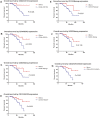Prognostic factors of palatal mucoepidermoid carcinoma: a retrospective analysis based on a double-center study
- PMID: 28262804
- PMCID: PMC5338264
- DOI: 10.1038/srep43907
Prognostic factors of palatal mucoepidermoid carcinoma: a retrospective analysis based on a double-center study
Abstract
Mucoepidermoid carcinoma (MEC) of the palate is a common malignancy of minor salivary glands. This study was designed to identify the prognostic factors for MEC of the palate. The medical records of patients diagnosed with MEC of the palate who visited the Department of Oral and Maxillofacial Surgery at Nanjing Stomatological Hospital and the Department of Stomatology at Central Hospital of Xuzhou were retrospectively studied. The prognostic factors were determined using a Cox proportional hazards model. Furthermore, the expression of cancer stem cell (CSC) markers CD44, CD133, Nanog and Sox2 were detected in neoplastic samples of these patients by immunohistochemistry. As a result, both univariate analysis and multivariate analysis proved a high histological grade and an advanced tumor stage as negative prognostic factors for overall survival. By immunohistochemistry staining and survival analysis, a combination of CD44/CD133/SOX2 was found to have the strongest prognostic value for palatal MEC patients. In conclusion, the proposed nomogram which include histological grade and tumor stage along with cancer stem cell markers provides a more accurate long-term prediction for palatal MEC patients.
Conflict of interest statement
The authors declare no competing financial interests.
Figures






Similar articles
-
Embryonic stem cells markers Oct4 and Nanog correlate with perineural invasion in human salivary gland mucoepidermoid carcinoma.J Oral Pathol Med. 2017 Feb;46(2):112-120. doi: 10.1111/jop.12449. Epub 2016 May 1. J Oral Pathol Med. 2017. PMID: 27131799
-
SHH Expression Is Significantly Associated With Cancer Stem Cell Markers in Oral Squamous Cell Carcinoma.Anticancer Res. 2021 Nov;41(11):5405-5413. doi: 10.21873/anticanres.15352. Anticancer Res. 2021. PMID: 34732409
-
Mucoepidermoid carcinoma of the palate in adolescence.J Dent Child (Chic). 2015 Jan-Apr;82(1):57-61. J Dent Child (Chic). 2015. PMID: 25909845
-
Mucoepidermoid carcinoma of minor salivary glands: a clinical study of 16 cases and review of the literature.Oral Dis. 2006 Jul;12(4):364-70. doi: 10.1111/j.1601-0825.2005.01166.x. Oral Dis. 2006. PMID: 16792720 Review.
-
Mucoepidermoid carcinoma misdiagnosed as palatal odontogenic infection: an overview on the differential diagnosis of palatal lesions.Coll Antropol. 2010 Dec;34(4):1473-9. Coll Antropol. 2010. PMID: 21874742 Review.
Cited by
-
Oral Cancer Stem Cells: Therapeutic Implications and Challenges.Front Oral Health. 2021 Jul 21;2:685236. doi: 10.3389/froh.2021.685236. eCollection 2021. Front Oral Health. 2021. PMID: 35048028 Free PMC article. Review.
-
Pluripotent stem cell marker deficiency in salivary mucoepidermoid carcinoma with relevance to molecular profiling: An experimental study.Saudi Dent J. 2025 Jun 6;37(4-6):16. doi: 10.1007/s44445-025-00018-x. Saudi Dent J. 2025. PMID: 40478494 Free PMC article.
-
Cancer stem cell markers in adenocarcinoma of the salivary glands - reliable prognostic markers?Eur Arch Otorhinolaryngol. 2021 Jul;278(7):2517-2528. doi: 10.1007/s00405-020-06389-7. Epub 2020 Oct 3. Eur Arch Otorhinolaryngol. 2021. PMID: 33009929 Free PMC article.
-
The Immunoexpression and Prognostic Significance of Stem Cell Markers in Malignant Salivary Gland Tumors: A Systematic Review and Meta-Analysis.Genes (Basel). 2024 Dec 29;16(1):37. doi: 10.3390/genes16010037. Genes (Basel). 2024. PMID: 39858584 Free PMC article.
-
NANOG expression in human development and cancerogenesis.Exp Biol Med (Maywood). 2020 Mar;245(5):456-464. doi: 10.1177/1535370220905560. Epub 2020 Feb 10. Exp Biol Med (Maywood). 2020. PMID: 32041418 Free PMC article. Review.
References
-
- Brandwein M. S. et al.. Mucoepidermoid carcinoma: a clinicopathologic study of 80 patients with special reference to histological grading. The American journal of surgical pathology 25, 835–845 (2001). - PubMed
-
- Goode R. K., Auclair P. L. & Ellis G. L. Mucoepidermoid carcinoma of the major salivary glands: clinical and histopathologic analysis of 234 cases with evaluation of grading criteria. Cancer 82, 1217–1224 (1998). - PubMed
-
- Speight P. M. & Barrett A. W. Salivary gland tumours. Oral diseases 8, 229–240 (2002). - PubMed
Publication types
MeSH terms
Substances
LinkOut - more resources
Full Text Sources
Other Literature Sources
Research Materials
Miscellaneous

